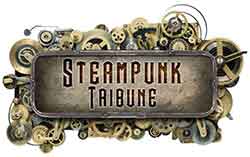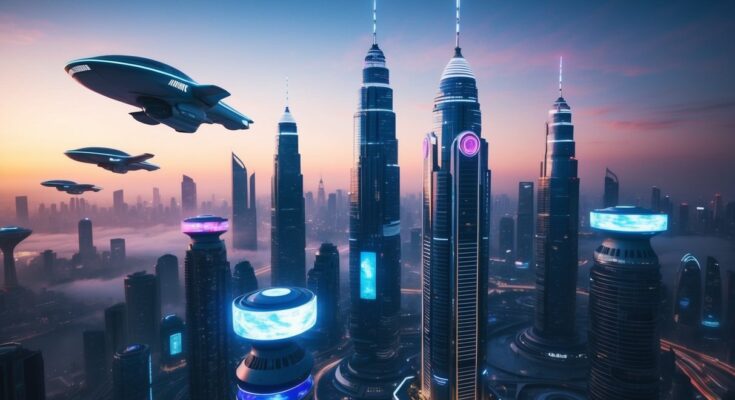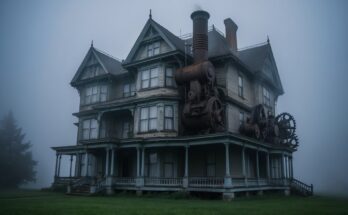Atompunk movies transport audiences to a universe where the aesthetics of the mid-20th century intertwine with a speculative vision of the future. This genre is characterized by its retro-futuristic style, blending elements of 1950s and 1960s design with themes of advanced technology and nuclear energy. Atompunk offers a unique lens through which to explore societal hopes and anxieties during the atomic age.

The genre captivates viewers with its unique blend of nostalgia and wonder, often showcasing worlds powered by nuclear technology and rich in Cold War era iconography. These films can serve as a reflection of both optimism and fear that defined an era marked by rapid technological advancement and geopolitical tension. By engaging with these contrasting emotions, atompunk films continue to resonate with modern audiences.
Through vibrant visuals and imaginative storytelling, atompunk movies offer an engaging commentary on the past and future. Each film invites viewers to consider how far society has come and what the future might hold, keeping the genre relevant and intriguing. The blend of history and futuristic fantasy ensures that atompunk remains a compelling topic for exploration in cinema.
The Atompunk Aesthetic

The Atompunk aesthetic captures the spirit of the 1950s and 1960s, with an emphasis on futuristic designs and cultural optimism rooted in the Atomic Age. This unique aesthetic blends Art Deco influences with the bold and imaginative style known as Raygun Gothic.
Defining Atompunk
Atompunk is a subgenre of speculative fiction and visual design that draws inspiration from mid-20th century visions of the future. It is characterized by its focus on atomic energy, space exploration, and retro-futuristic technology. Unlike other “punk” subgenres, Atompunk embraces a mix of hope and fear about technology’s potential.
Its imagery is filled with space rockets, ray guns, and futuristic cities. These elements reflect a time when technology promised new frontiers. Atompunk diverges from Steampunk and Dieselpunk by focusing on scientific advancements and cultural shifts during the post-war period.
Historical Context: The Atomic Age
The Atomic Age, spanning roughly from the late 1940s to the early 1970s, is integral to the Atompunk aesthetic. It was a time when nations harnessed nuclear power and explored space. People were captivated by the potential of atomic energy and fearful of its destructive power.
The Cold War heightened these feelings, leading to the proliferation of nuclear-themed media. This era also sparked innovation in design and architecture, shaping modernist buildings and futuristic concepts. The Atomic Age’s dual themes of optimism and apprehension are central to Atompunk.
Visual Style and Art Deco Influence
Atompunk visuals often incorporate elements from Art Deco, blending streamlined forms and geometric patterns with futuristic motifs. The bold curves and sharp angles of Raygun Gothic architecture reflect these influences. Googie architecture, seen in diners and motels, embodies this style with its cantilevered roofs and neon signage.
This visual style uses bright colors, metallic surfaces, and whimsical shapes. Dioramas and model kits featuring retro rockets and space colonies exemplify the aesthetic. While distinct, its ties to Art Deco offer a continuity of elegance and modernism.
Fashion and Lifestyle
Fashion in the Atompunk aesthetic draws from 1950s and 1960s styles, characterized by sleek lines and bold colors. Men’s wear may include slim-fitting suits and narrow ties, while women’s fashion features atomic prints and space-age materials like polyester.
Lifestyle elements reflect an era enamored with science and progress. Popular culture of the time, such as movies and comics, depicted jetpacks, hovercars, and household robots. This aesthetic is often seen in retro diners and themed attractions that replicate the period’s look.
Atompunk in Literature
Atompunk literature emphasizes futuristic stories with atomic-age technology. This genre mixes speculative fiction with elements from the 1950s and 1960s. Influential works often reflect on humanity’s relationship with technology and potential new societies.
Prominent themes involve space travel, utopian dreams, and the ethical challenges of nuclear power. Authors from this period crafted narratives where atomic science could either save or doom civilization. The tension between innovation and catastrophe is a recurring motif in Atompunk literature.
Atompunk vs. Steampunk and Dieselpunk
Atompunk distinguishes itself from Steampunk and Dieselpunk through its distinct focus on mid-20th-century innovation. While Steampunk draws from Victorian-era steam power, and Dieselpunk from interwar period mechanics, Atompunk leans into atomic energy and space-age dreams.
It explores both the optimism and anxiety of this period. The aesthetic incorporates futuristic visions seen in mid-century designs. While similar in their speculative nature, each “punk” genre reflects different historical influences and technological ideologies.
Atompunk in Film and Television

Atompunk is a captivating genre that combines retro-futuristic aesthetics with themes often tied to mid-20th-century optimism and anxiety about atomic age technology. Many films and television shows embrace this aesthetic through storytelling lenses.
Iconic Atompunk Movies
Several films exemplify atompunk’s vivid visuals and narratives. 2001: A Space Odyssey presents a fascinating blend of space exploration and advanced technology, capturing the era’s fascination with the future. The Incredibles, although primarily a superhero film, skillfully integrates atompunk design elements with its depiction of sleek, futuristic cities and technology. These movies highlight how the fusion of mid-century aspirations and cautionary tales contribute to the atompunk allure.
Atompunk Television Shows
Television also embraced atompunk. The Jetsons offered a humorous, yet optimistic vision of the future filled with flying cars and robotic housekeepers, embodying the dreams of the atomic age. Futurama took a more satirical approach, showcasing futuristic adventures while subtly critiquing technological advancements. Both shows demonstrate how atompunk aesthetics and themes continue to captivate audiences through dynamic storytelling.
Themes and Narrative Elements
Atompunk themes often focus on the duality of technological progress and its potential perils. Characters frequently navigate worlds where nuclear power and advanced machines coexist with everyday life. Stories explore technological optimism and its possible consequences, reflecting societal hopes and fears of the era. This dynamic interplay between innovation and caution provides a rich backdrop for storytelling.
Influence on Modern Cinema
Modern cinema feels atompunk’s influence as it nods to past visions of the future. Films like Star Wars and Star Trek embrace similar visual styles, melding past aesthetics with advanced technologies in their world-building. The genre inspires filmmakers to revisit mid-century futurism, blending nostalgia with contemporary storytelling, thereby keeping atompunk elements alive in modern narratives.
The Role of Dystopian Narratives
Dystopian narratives play a pivotal role in atompunk by highlighting the darker aspects of technological advance. While many stories celebrate progress, others focus on the catastrophic potential of unchecked ambitious endeavors. This blend of utopian and dystopian themes allows for complex narratives, showcasing the spectrum of atomic age possibilities that continues to resonate within the genre.
Atompunk in Other Media
Atompunk aesthetics reach beyond films, embracing diverse media forms. Music, video games, and comics often capture the retro-futuristic vision and nuclear optimism that characterize atompunk. These different outlets highlight unique aspects of this imaginative subgenre.
Music and Atompunk Vibes
Music connected to atompunk embraces the technological optimism and futurism of the mid-20th century. It often incorporates electronic sounds reminiscent of the 1950s and 1960s. Bands and artists evoke nostalgia through synthesizers and theremins. Songs often reflect themes from the Cold War era, capturing both hope and anxiety over nuclear technology and space exploration.
Lyrics may explore space-age dreams or confront the existential dread of the atomic age. The style often merges with genres like synthwave, enhancing the retro-futuristic atmosphere that defines atompunk’s musical influence.
Atompunk in Video Games
In video games, atompunk influences settings, narratives, and aesthetics, providing players with a distinctive retro-futuristic experience. Iconic games such as The Outer Worlds and the Fallout series depict societies shaped by atomic age innovations.
These worlds mix 1950s-style technology with dystopian elements, creating detailed environments and stories. Titles like Prey and Destroy All Humans showcase atompunk’s capacity to blend humor and social commentary. Players explore alternative histories where nuclear energy changes societal dynamics.
Comic Books and Graphic Novels
Comic books and graphic novels in the atompunk genre explore alternative futures and pivotal technological advances. Works like Flash Gordon and Ignition City bring atompunk’s visual and narrative styles to life. These comics blend classic sci-fi themes with atomic age motifs.
They often depict space exploration and futuristic cities. Series such as Foundation incorporate atompunk aesthetics alongside elaborate plots, showcasing the genre’s flexibility. Art styles mix retro designs with imaginative, speculative elements, offering readers a captivating blend of nostalgia and innovation.
Cultural and Social Impact
Atompunk movies have left a lasting imprint on both architecture and pop culture. Their influence can be seen in the unique design elements of buildings and cities, as well as in the pervasive themes and aesthetics found in various media forms.
Impact on Architecture and Urban Design
Atompunk aesthetics often highlight futuristic design influenced by the Space Race era. This includes visions of floating space stations and sleek rockets. Architecture from this time often embraced bold geometric shapes and lines.
The influence extended to the suburban lifestyle, seen in the rise of the nuclear family. Suburban homes echoed the clean, modern aesthetics seen in atompunk narratives. Many urban planners were inspired by these films, incorporating elements that suggested progress and technological advancement.
Homes and public buildings sometimes included space-age motifs, with murals and sculptures that imagined life on the Moon or other planets. These designs were meant to evoke a sense of hope and technological triumph, reflecting society’s dreams of a space-faring future.
Legacy in Pop Culture
Atompunk has deeply embedded itself in pop culture, influencing many forms of media. Television shows, literature, and music adopted themes of technological optimism and cosmic exploration.
Classic films from this genre have become cultural touchstones, referenced in modern movies and series. The ongoing fascination with retro-futurism and the reigniting of interest in the early days of the Space Race highlight atompunk’s enduring relevance.
Nostalgia for this period continues to inspire new works, showcasing the blend of culture, technology, and aesthetics that characterized the era. The legacy persists in mediums like graphic novels and fashion, proving the lasting appeal of its unique style.
Contemporary Atompunk
Contemporary Atompunk blends retro-futuristic aesthetics and ideas with modern interpretations. Its resurgence is noted in art, media, and culture, capturing the imagination of those fascinated by mid-20th-century science fiction.
The Resurgence of Atompunk
In recent years, there has been a noticeable resurgence in Atompunk culture. This can be seen in a variety of media, including films, video games, and literature. It draws inspiration from the optimistic yet anxious period of the Atomic Age, combining nostalgia with futuristic design.
This resurgence often features an imaginative blend of nuclear-era aesthetics with current societal themes, resonating with audiences. The renewed interest is driven by a fascination with how the past envisioned the future, utilizing technology as a storytelling tool. The aesthetic appeal of Atompunk lies in its ability to blend vintage technology with contemporary narratives, offering a unique visual and thematic experience.
Atompunk in Modern Art
In modern art, Atompunk has manifested in various forms, infusing old-world designs with innovative artistry. Artists explore themes of nuclear energy and technological advancement through paintings, sculptures, and digital media. The bold use of color and retro-futuristic themes are staples in these works.
Atompunk art often serves as social commentary, reflecting concerns about technology and progress. The melding of past and future elements in these art pieces challenges perceptions and encourages viewers to reconsider the impact of historical scientific advancements. The aesthetic of Atompunk art is a key draw, appealing to both nostalgia and future curiosity.
The Atompunk Community
The Atompunk community consists of enthusiasts who celebrate the unique cultural and aesthetic elements of the genre. They partake in various subculture activities, including cosplay, conventions, and online forums. This community fosters creativity and shared interest in retro-futurism and imaginative storytelling.
Interacting through social media and dedicated platforms, Atompunk fans exchange ideas, artwork, and stories, contributing to a vibrant and active scene. They are often united by a shared interest in science fiction and the cultural impact of the Atomic Age. This camaraderie enhances the relevance of Atompunk, keeping its appeal alive in modern culture.
Theoretical and Philosophical Underpinnings
Atompunk movies reflect distinct aspects of speculative fiction by exploring futuristic and dystopian worlds. These films often involve themes like post-apocalyptic survival, time travel, and alternate histories, allowing audiences to engage with imaginative and thought-provoking concepts.
Atompunk and The Speculative Fiction Spectrum
Atompunk finds its place within the speculative fiction genre by introducing a retro-futuristic vision often set between the 1940s and 1960s. It borrows elements from the Atomic Age and features technological advancements that are both promising and perilous. This subgenre often blurs the line between utopian and dystopian settings, providing fertile ground for stories that question social and technological progress.
Films may feature imagined futures, where humanity thrives or struggles amid technological marvels and setbacks. Through this lens, Atompunk reflects societal anxieties about nuclear power and advanced technologies. Themes like alien encounters and scientific breakthroughs play crucial roles, serving as a backdrop for exploring ethical dilemmas and existential risks in speculative contexts.
Post-apocalyptic Narratives and Atompunk
Post-apocalyptic elements are frequently present in Atompunk works, where humans must navigate a world marred by nuclear catastrophe. This often emphasizes themes of survival and regeneration. The narratives portray societies attempting to rebuild amid the remnants of a decimated civilization. The films captivate audiences by exploring the resilience and adaptability of humanity in the face of existential threats.
Central to these stories is the tension between destruction and hope. Technology is both a savior and a destroyer. Characters are depicted in stark landscapes populated by remnants of old societies. Atompunk uses these backdrops to raise questions about humanity’s future, our reliance on technology, and the choices that led to ruinous outcomes.
Time Travel and Alternate Histories
Time travel plays a significant role in Atompunk, offering narratives filled with paradoxes and alternate realities. These films often explore “what-if” scenarios where historical events unfold differently due to nuclear discoveries or interventions. In such stories, characters might journey through time to alter or observe consequential moments, creating new timelines or preventing disasters.
Alternate histories allow the reimagining of pivotal moments where atomic technology had significant impacts. By bending time and history, Atompunk offers a space to explore causality and the ripple effects of technological interference. These frameworks provide an opportunity to reflect on the precarious balance between innovation and the potential for irreversible change.
Comparative Analysis
Atompunk movies and cyberpunk narratives share certain thematic elements but differ significantly in aesthetics and societal messages. Atompunk often incorporates romantic elements, providing a contrast to the more gritty and dystopian themes of cyberpunk.
Atompunk and Cyberpunk
Atompunk and cyberpunk differ in their depiction of technology and society. Atompunk is rooted in the optimism and aesthetics of the Atomic Age. It showcases retro-futuristic designs and often highlights the idealized technological advancements of the mid-20th century.
Cyberpunk, on the other hand, depicts a dystopian future where technology has advanced to create virtual realities and artificial intelligence. It often explores themes of societal decay, corporate domination, and identity crises. Key elements such as neon-lit cityscapes and advanced computer networks mark cyberpunk worlds.
In comparison, atompunk tends to focus on exploration, both technological and spatial, showing an era of experimentation and bold dreams. This creates a stark difference in tone and message between the two genres.
Romantic Elements in Atompunk
Romantic elements often feature prominently in atompunk films. These narratives usually include idealized relationships set against the backdrop of futuristic innovation. Characters may find themselves in love stories intertwined with technological quests or scientific discoveries.
The portrayal of romance in atompunk contrasts with cyberpunk, where relationships often appear strained by technological influences. In atompunk, love often symbolizes hope and human connection in a world of mechanical wonders.
These romantic subplots provide a layer of emotional depth, balancing the scientific and futuristic themes prevalent in the genre. Romantic narratives in atompunk thus offer stories of personal growth and adventure aligned with the optimistic vision of the future typical of the genre.
Key Works and Influences
Atompunk cinema draws inspiration from notable literary and cinematic works that reflect technological optimism and Cold War-era aesthetics. This section explores the literature that shaped the genre and highlights important films that became milestones in the evolution of atompunk.
Literary Inspirations for Atompunk
Literature has played a significant role in shaping atompunk’s themes and aesthetics. Classics like Isaac Asimov’s Foundation series highlight the intricate dance between technology and society. Meanwhile, Philip K. Dick’s Do Androids Dream of Electric Sheep? explores questions of identity and artificial intelligence amidst a future dystopia.
These works influenced the narrative depth and philosophical undertones of atompunk films. Arthur C. Clarke’s 2001: A Space Odyssey is another pivotal inspiration, emphasizing humanity’s relationship with space travel and technology. The blend of speculative fiction with philosophical questions creates a fertile ground for atompunk storytelling.
Cinematic Milestones
In cinema, atompunk is marked by its unique visual style and exploration of futuristic themes. Stanley Kubrick’s 2001: A Space Odyssey stands out for its visionary depiction of space exploration. George Lucas’s Star Wars also presents a universe rich in retro-futuristic aesthetics, combining advanced technology with classic storytelling.
These films contributed to the atompunk genre by pushing boundaries in special effects and narrative styles. They established a visually compelling and thematically rich landscape that continues to influence filmmakers. Each cinematic milestone brings a blend of imaginative worlds and complex characters, solidifying atompunk’s place in film history.




